Exploring Lung Pathologies with Physiology & Pathology
Posted on 11/12/19 by Adelaide Elkin
Visible Body’s newest app, Physiology & Pathology, features illustrations, animations, and 3D models covering a wide range of common pathologies of various body systems. In today’s blog post, we’ll use Physiology & Pathology to explore five respiratory pathologies!
The lungs are a primary part of the respiratory system. These two large, cone-shaped chambers protected by the thoracic cage supply each cell in the body with oxygen. The lungs also help to regulate your body temperature, support your sense of smell, and get rid of harmful substances (through coughing, sneezing, swallowing, etc.).
Lung Structure & Function
Each lung is encased in a thin double-layered serous membrane called the pleura. Between the two layers is fluid that prevents the lungs from chafing against the thorax wall.
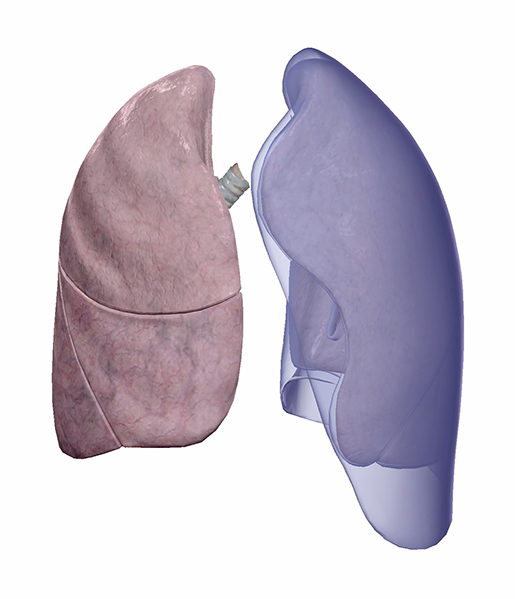 The lungs and pleurae. Image from Human Anatomy Atlas 2020.
The lungs and pleurae. Image from Human Anatomy Atlas 2020.
Each lung is divided into sections or lobes. The right lung has three (superior, middle and inferior) and the left lung has two (upper and lower).
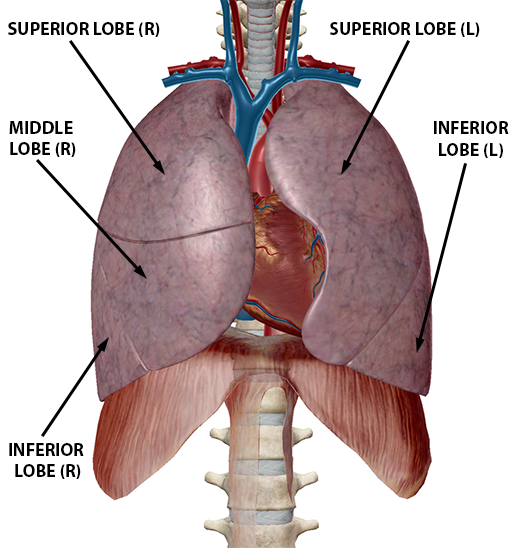 Lobes of the lungs. Image from Physiology & Pathology.
Lobes of the lungs. Image from Physiology & Pathology.
The lungs have a spongy, light, and elastic texture that allows them to expand and contract during breathing. Air (78% N2, 21% O2, and 1% other gases) fills the lungs as we breathe. Oxygen is then transported from the lungs into the bloodstream and then to the body’s cells. As cells take in oxygen, they exchange it for carbon dioxide, a waste gas. The carbon dioxide is then transported back to the lungs through the bloodstream and breathed out.
Fun fact: this is why we have a mutualistic relationship with trees! Trees emit oxygen which we breathe in, while humans emit carbon dioxide which trees need for respiration.
Lung Pathologies
But back to the lungs. They clearly play a crucial role in keeping us alive; however, the lungs can also be subject to an array of dangerous health issues. Here are five common lung pathologies and what they do.
1. Lung Cancer
Just to get the worst one over with, lung cancer is the leading cause of cancer death in the United States. It is commonly the result of cigarette smoking, but can also occur in people who have had frequent exposure to second-hand smoke or even those who have never smoked at all.
Those cancer-ridden logs that people call cigarettes contain a plethora of carcinogenic (cancer-causing) substances which, when inhaled, make direct contact with delicate lung tissue. The smoke destroys the cells that line the lungs, and with prolonged exposure, will cause irreversible damage.
There are two types of lung cancer that can occur: small cell lung cancer which occurs mainly in excessive smokers, and non-small cell lung cancer which is an umbrella term for a variety of similar lung cancers.
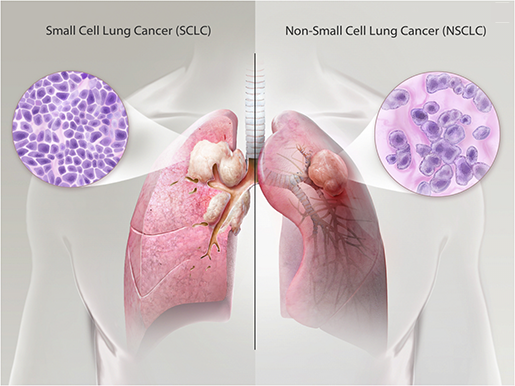 Small cell and non-small cell lung cancer comparison. Illustration from Physiology & Pathology.
Small cell and non-small cell lung cancer comparison. Illustration from Physiology & Pathology.
2. COPD
Chronic bronchitis and emphysema are the two most common forms of chronic obstructive pulmonary disease (COPD). They are often the result of tobacco/cigarette smoking or exposure to other carcinogens.
When we inhale, the air travels from the trachea, through the bronchi and into the lungs. Chronic bronchitis is an inflammation of the airways that causes bronchoconstriction (narrowing of the bronchi). This makes breathing more difficult and causes excessive mucus production, as well as coughing/wheezing.
In emphysema, there is damage to the tissue inside the lungs’ smallest airways. During inhalation, the airways expand, but during exhalation, the tissue is unable to fully contract, leaving air trapped inside the alveoli.
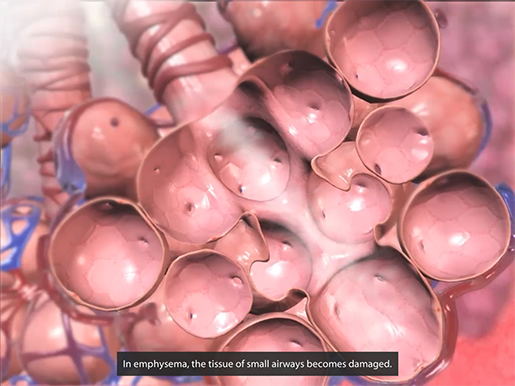 Animation screenshot from Physiology & Pathology.
Animation screenshot from Physiology & Pathology.
As bad as it sounds, COPD is treatable with a variety of medications, lung therapies, or surgery.
3. Asthma
A very common condition found in people of all ages (so inclusive!), asthma makes breathing more of a task than it should be due to swollen and narrowed airways and the overproduction of mucus. This is the result of a trigger causing the airway’s defenses to overreact. Other symptoms such as wheezing, shortness of breath, coughing, or chest pain can occur with asthma too.
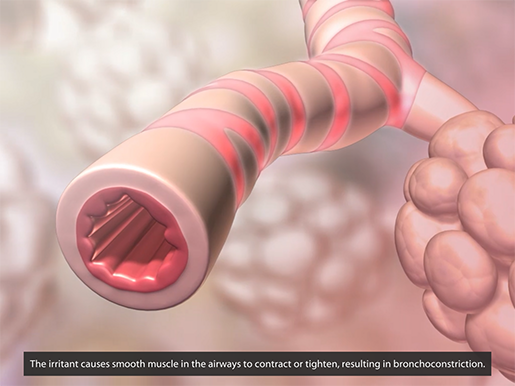 Bronchoconstriction in asthma. Animation screenshot from Physiology & Pathology.
Bronchoconstriction in asthma. Animation screenshot from Physiology & Pathology.
Asthma presents itself in a range of ways. The severity of the condition can vary, and triggers are different from person to person. Things like exercise, exposure to certain chemicals/dust, stress, cold air, or allergens are all common triggers. The only known causes of asthma are genetics and environmental factors.
Luckily, asthma is very treatable. Depending on the characteristics of each person's condition, a variety of oral medications, inhaled medications, and shots are available.
4. Tuberculosis
Tuberculosis (TB) is a highly contagious disease that can be contracted through bacteria released into the air from a cough, sneeze, laugh, spit, etc. This, my friends, is why you must cover your mouth when you sneeze or cough!
When a person contracts TB, nodules called tubercles form in the lungs to try to contain the bacteria, but they eventually rupture.
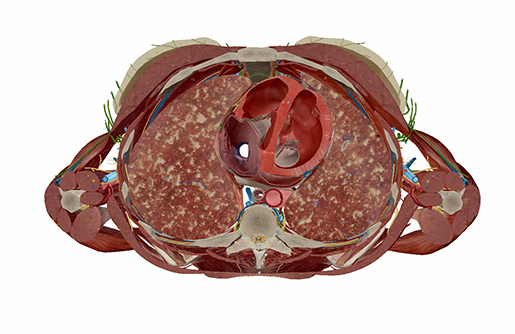 3D cross-section of lungs with tuberculosis. Image from Physiology & Pathology.
3D cross-section of lungs with tuberculosis. Image from Physiology & Pathology.
The disease mainly affects the lungs, but if severe, can also affect other parts of the body such as the spine, brain, or kidneys. The disease can show up in one of two forms: latent or active. In latent TB, the bacteria remains in the system but in a dormant state so there are no symptoms and is not contagious. However, the disease can still be activated, so treatment is still necessary.
In active TB, the bacteria are active, therefore making you sick and contagious. Although treatable, the disease may take months to be completely removed from the system since many types of tuberculosis are drug resistant and have the potential to develop antibiotic resistance, so it may take time to find the right medication.
5. Pneumonia
The bronchi are a network of branching tubes that bring air into and out of the lungs. At the ends of their smallest branches are clusters of tiny air sacs called alveoli that fill with air when we inhale.
Pneumonia is an infection that occurs when the alveoli become inflamed and fill with blood, pus, or fluid. This can cause difficulty breathing, a cough with phlegm or pus, and a fever.
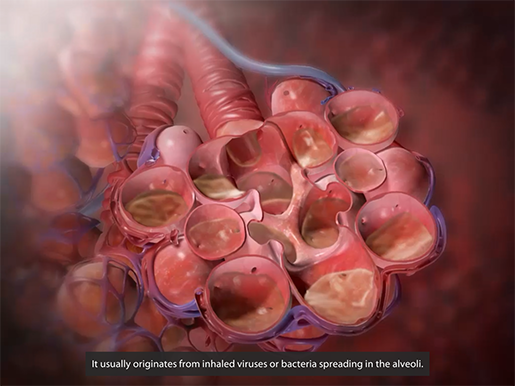 Alveoli with pneumonia. Animation screenshot from Physiology & Pathology.
Alveoli with pneumonia. Animation screenshot from Physiology & Pathology.
The severity of the infection can range from mild to life-threatening depending on the type of pathogen that initiated the infection (which can be a variety of organisms like fungi, bacteria, or viruses). The most serious cases typically occur in infants, young children, or adults over the age of 65. The infection is curable with treatments such as antibiotics, pain relievers, or cough medicine. Hospitalization may be necessary if the infection worsens.
And there you have it—the facts on five common respiratory pathologies! Explore these and more in Physiology and Pathology.
Be sure to subscribe to the Visible Body Blog for more anatomy awesomeness!
Are you an instructor? We have award-winning 3D products and resources for your anatomy and physiology course! Learn more here.
Additional Sources:



